New Zealand is a sovereign island country in the southwestern Pacific Ocean. The history of New Zealand dates back 700 years to when it was discovered. It is one of the world’s best places to live and study.
We all know that it is famous for its honey, wine, Kiwifruit, and watersports. But very few of us know that it is famous for inventions and agriculture as well.
Let’s explore more about this country and have a look at the top 20 interesting facts about New Zealand.
Interesting Facts About New Zealand
1. Official Language
English, Māori, and New Zealand Sign Language (NZSL) are the three official languages of New Zealand. These languages hold equal status and are recognized under the New Zealand Sign Language Act 2006 and the Māori Language Act 1987.
English is the most widely spoken language in New Zealand and is used for most official and everyday communication. Māori, the indigenous language of New Zealand, holds a special cultural significance and is spoken by a significant portion of the population. Efforts have been made to revitalize and promote the use of the Māori language, which is taught in schools and used in various official settings.
New Zealand Sign Language (NZSL) is the primary language used by the Deaf community in New Zealand. It became an official language in 2006, recognizing the importance of sign language as a means of communication for the Deaf community. NZSL interpreters are provided in many official settings to ensure accessibility for Deaf individuals.
These three languages reflect the multicultural and diverse nature of New Zealand society and are an integral part of the country’s identity and cultural heritage.
2. World’s First Commercial Bungee Jump
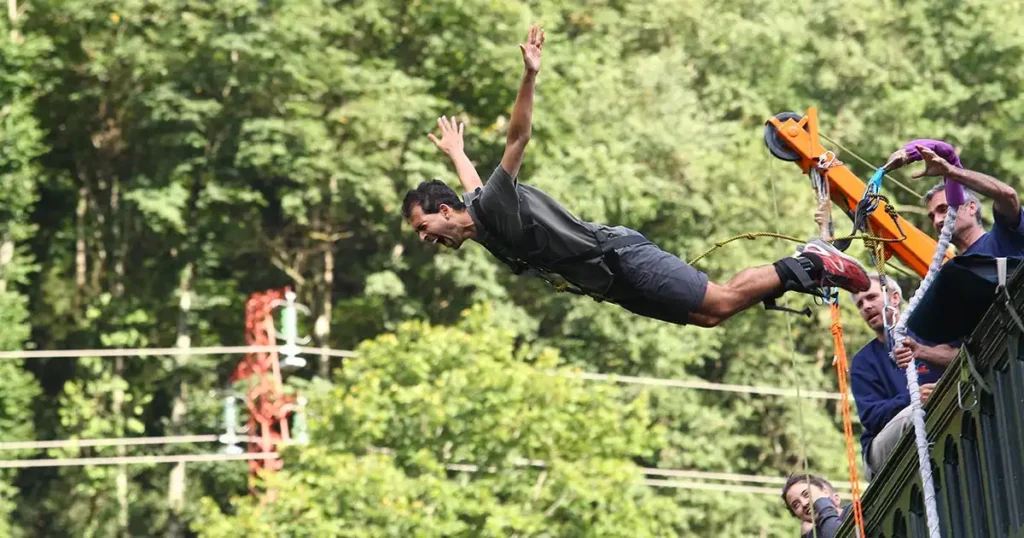
The world’s first commercial bungee jump was indeed started in Queenstown, New Zealand, in 1988.
The jump took place off the Kawarau Bridge, which is located near Queenstown. The height of the bungee jump was 43 meters (141 feet).
This groundbreaking adventure activity was pioneered by A.J. Hackett and Henry van Asch, who founded the company A.J. Hackett Bungy.
Their innovative approach to recreational bungee jumping quickly gained international attention and popularity, leading to the establishment of bungee jumping as a thrilling adventure sport around the world.
Today, bungee jumping remains a popular activity for adrenaline seekers in various locations globally.
3. First to Climb Mount Everest
The first person to climb Mount Everest was a New Zealander. Sir Edmund Hillary first time climbed Mount Everest in 1953.
He was part of a British expedition led by Sir John Hunt that successfully reached the summit of Mount Everest on May 29, 1953.
Hillary, along with the Sherpa mountaineer Tenzing Norgay, became the first individuals confirmed to have reached the summit of Mount Everest.
Their achievement was a landmark in the history of mountaineering and a significant milestone for human exploration.
Sir Edmund Hillary’s accomplishment brought him international recognition and he became a prominent figure in New Zealand and the mountaineering community worldwide.
Ready to be blown away by the awe-inspiring marvel that is Mount Everest? Discover 20 mind-blowing facts about Mount Everest, the world’s tallest peak that will leave you in awe of its grandeur and challenge your understanding of what’s possible.
4. Rights to Vote
New Zealand holds the distinction of being the first country in the world to grant women the right to vote in national elections.
This milestone in women’s suffrage occurred in 1893 with the passage of the Electoral Act of 1893. The act extended voting rights to all adult women, making New Zealand the trailblazer in promoting gender equality and political participation.
The suffrage movement in New Zealand was led by prominent activists such as Kate Sheppard, who played a significant role in advocating for women’s rights and social reforms.
The achievement of women’s suffrage in New Zealand had a profound impact on the global suffrage movement, inspiring women in other countries to fight for their own voting rights.
5. No Nuclear Power Station
New Zealand does not have any nuclear power stations. The country has chosen to pursue alternative sources of energy for its power generation.
New Zealand’s electricity generation primarily relies on renewable energy sources such as hydroelectric power, geothermal power, wind power, and to a lesser extent, solar power.
These renewable sources contribute to a significant portion of the country’s electricity generation.
The decision to not have nuclear power stations in New Zealand is rooted in the country’s nuclear-free policy.
In the mid-1980s, New Zealand enacted legislation that declared the country a nuclear-free zone. This policy prohibits the entry of nuclear-powered or nuclear-armed ships into New Zealand’s waters and bans the establishment of nuclear power plants on its soil.
The nuclear-free policy is a reflection of New Zealand’s strong stance against nuclear weapons and its commitment to environmental preservation. The country has chosen to prioritize renewable energy options to meet its power needs while minimizing the potential risks associated with nuclear energy.
6. Rugby World Cup
New Zealand won the inaugural Rugby World Cup, which was held in 1987. The tournament took place from May 22 to June 20, 1987, with matches held in both New Zealand and Australia.
The New Zealand national rugby union team, known as the All Blacks, emerged victorious in the tournament.
The Rugby World Cup was a significant milestone for the sport of rugby union, as it marked the first global competition of its kind. The New Zealand team, led by captain David Kirk and coached by Sir Brian Lochore, delivered an outstanding performance throughout the tournament.
In the final, held at Eden Park in Auckland, New Zealand defeated France with a score of 29-9, securing their victory and becoming the first-ever Rugby World Cup champions.
This triumph sparked a tradition of success for New Zealand in international rugby, as the All Blacks have gone on to win the Rugby World Cup on three more occasions, in 2011, 2015, and 2019, cementing their status as one of the most successful and dominant teams in the history of the sport.
7. Olympic Gold Medal
New Zealand has achieved remarkable success in the Olympic Games relative to its population size. With a population of around 5 million people, New Zealand has consistently performed exceptionally well in the Olympics, particularly in certain sports.
When looking at the number of Olympic gold medals per capita, New Zealand has indeed emerged as one of the top-performing nations.
The country has produced numerous outstanding athletes who have excelled in various disciplines, including athletics, rowing, sailing, cycling, and rugby sevens, among others.
While New Zealand’s success in the Olympics is impressive relative to its population, it’s worth noting that larger nations with greater resources and larger talent pools may often have higher overall medal counts.
Nonetheless, New Zealand’s achievements in the Olympic Games have been remarkable, and the country continues to produce talented athletes who excel on the global stage.
8. World’s Only Flightless Parrot
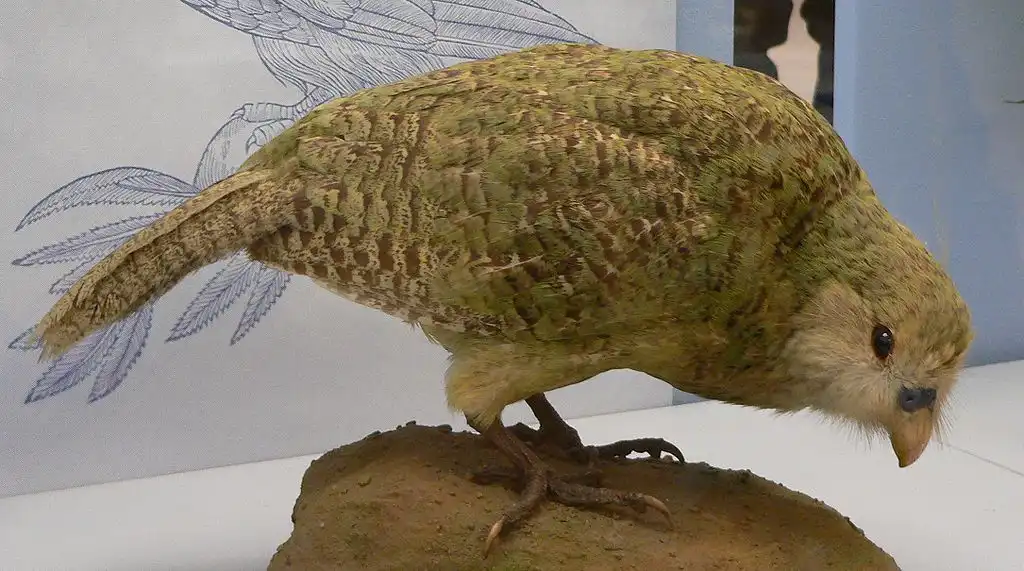
New Zealand is indeed the home of the Kakapo (Strigops habroptilus), which is the world’s only flightless parrot. The Kakapo is a unique and critically endangered species that is endemic to New Zealand. It is also known as the owl parrot due to its owl-like appearance and nocturnal behavior.
The Kakapo is a large, green parrot with a stout body and short wings. It is known for its distinctive facial disc, which resembles that of an owl.
This nocturnal parrot is primarily herbivorous, feeding on leaves, bark, fruits, seeds, and even pollen. It is known for its characteristic booming call, which males use to attract mates and establish their territories.
Unfortunately, the Kakapo population has drastically declined due to habitat loss, introduced predators, and low breeding rates.
Efforts have been made to conserve and protect this endangered species, including dedicated breeding programs and strict predator control measures.
As of my knowledge cutoff in September 2021, there were around 200 Kakapo individuals left, making them one of the rarest and most critically endangered parrot species in the world.
9. Longest Place Name
The longest name of a place in the world is Taumatawhakatangihangakoauauotamateapokaiwhenuakitanatahu, which is a hill located in the Hawke’s Bay region of New Zealand.
Pronunciation:
The name is of Māori origin and translates to “The summit where Tamatea, the man with the big knees, the climber of mountains, the land-swallower who traveled about, played his nose flute to his loved one.”
The name is often shortened to Taumata for convenience. It gained prominence for its length and uniqueness, attracting attention from around the world.
The Māori language is known for its descriptive and intricate word constructions, often reflecting historical or cultural significance.
It’s worth noting that Māori place names in New Zealand often hold deep cultural, historical, and spiritual significance.
They are an integral part of the country’s heritage and serve to honor the Māori people and their connection to the land.
10. Coolest Little Capital City
Wellington, the capital city of New Zealand, is often referred to as the “coolest little capital”. This nickname highlights Wellington’s unique and vibrant atmosphere, despite its relatively small size compared to other capital cities around the world.
The term “coolest” in this context refers to Wellington’s reputation as a hub of creativity, culture, and innovation. The city is known for its thriving arts and entertainment scene, with numerous theaters, galleries, music venues, and film production companies. It is also home to the country’s national museum, Te Papa Tongarewa, which showcases New Zealand’s rich cultural and natural heritage.
The “little” aspect of the nickname reflects Wellington’s compact size, making it easy to explore on foot. Despite its small geographical area, the city offers a wide range of attractions, restaurants, cafes, and bars, creating a lively and bustling atmosphere.
Overall, the nickname “coolest little capital” has become a popular way to capture Wellington’s unique charm and its reputation as a vibrant and culturally rich city.
11. Unique and Diverse Biodiversity
New Zealand is renowned for its unique and diverse biodiversity. The country’s isolation, along with its geological history, has contributed to the evolution of numerous endemic species that are found nowhere else in the world. Here are some notable examples:
Kiwi
The kiwi bird is a flightless bird and a national symbol of New Zealand. It is known for its distinctive appearance, with a long beak, small wings, and hair-like feathers. Kiwis are nocturnal and are considered vulnerable due to habitat loss and predation.
Tuatara
The tuatara is a reptile species endemic to New Zealand. It is often referred to as a “living fossil” as it is the last surviving member of an ancient reptilian order. Tuatara has a unique physiology and can live for over 100 years.
Silver Fern
The silver fern (Cyathea Dealbata) is an iconic symbol of New Zealand. It is a type of tree fern with silver-white undersides of the fronds. The silver fern holds cultural significance and is commonly associated with New Zealand sports teams.
Kakapo
The kakapo is a critically endangered parrot and one of the world’s rarest birds. It is flightless and known for its distinctive green plumage, owl-like face, and unique booming call.
Hector’s Dolphin
Hector’s dolphin is a small species of dolphin found only in New Zealand waters. It is one of the smallest and rarest dolphin species globally.
These examples represent just a fraction of New Zealand’s unique and endemic flora and fauna. The country’s commitment to conservation and environmental protection plays a crucial role in preserving these species and their habitats.
12. Corruptions Perception Index
According to the Corruption Perceptions Index (CPI) published by Transparency International, both Denmark and New Zealand have consistently ranked as the least corrupt nations in the world.
The Corruption Perceptions Index is an annual assessment that measures perceived levels of public sector corruption based on various indicators and expert assessments. Countries are assigned scores ranging from 0 to 100, with higher scores indicating lower levels of perceived corruption.
Denmark and New Zealand have often received high scores, indicating low levels of perceived corruption in their public sectors. These countries have established robust systems to promote transparency, integrity, and accountability, which contribute to their reputation as nations with low corruption levels.
It’s important to note that the CPI rankings can vary slightly from year to year, but both Denmark and New Zealand consistently perform well in terms of perceived levels of corruption.
13. World’s Smallest Dolphin Species
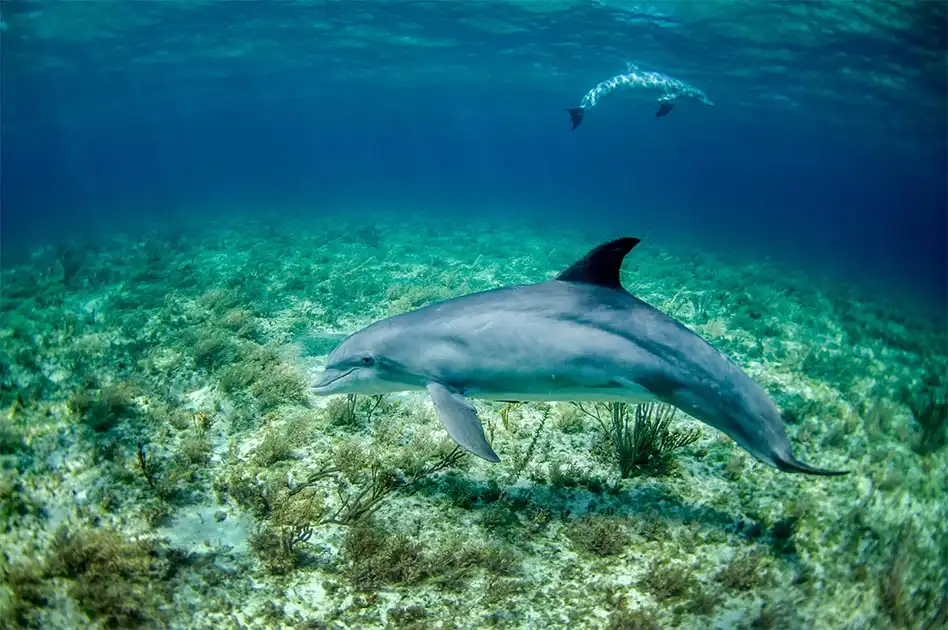
New Zealand is home to the world’s smallest dolphin species, known as the Hector’s dolphin (Cephalorhynchus Hectori).
Hector’s dolphins are native to the coastal waters of New Zealand, primarily found around the South Island and the central-eastern coast of the North Island.
They are known for their small size, with adult individuals typically measuring between 1.2 to 1.4 meters (3.9 to 4.6 feet) in length.
These dolphins have distinct black, gray, and white markings on their bodies. They are characterized by a rounded dorsal fin and a distinctive facial shape. Hector’s dolphins are highly acrobatic and are often seen playing and riding the waves.
It’s important to note that within New Zealand, there is a subspecies of Hector’s dolphin called the Māui dolphin (Cephalorhynchus Hectori Maui).
Māui dolphins are critically endangered and are considered one of the rarest dolphin species globally. They are found in a restricted area off the west coast of the North Island and are indeed the smallest and most endangered dolphin subspecies in the world.
14. Lord of the Rings Trilogy
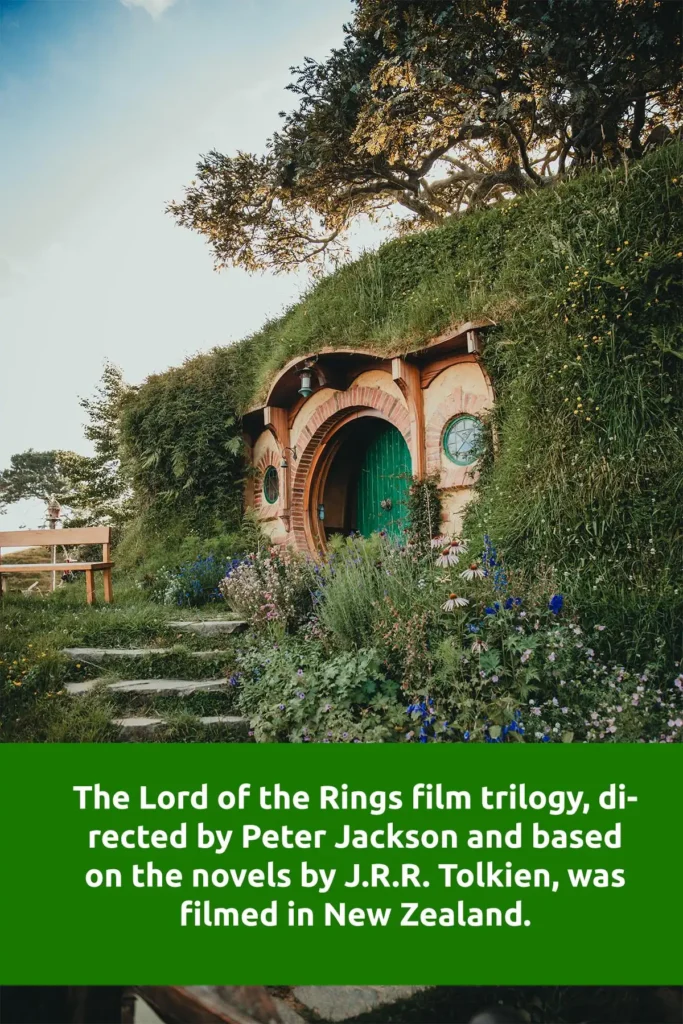
The Lord of the Rings film trilogy, directed by Peter Jackson and based on the novels by J.R.R. Tolkien, was filmed in New Zealand. The stunning landscapes and diverse natural beauty of New Zealand provided the perfect backdrop for the fictional Middle-earth.
Over 150 real-world locations throughout New Zealand were used to depict various iconic settings from the films. Some of the notable locations include:
Mordor
The dark and desolate land of Mordor was filmed primarily in Tongariro National Park, featuring the active volcanic peaks of Mount Ngauruhoe (which represented Mount Doom) and Mount Ruapehu.
Rivendell
The elven realm of Rivendell was portrayed in Kaitoke Regional Park near Wellington. The lush forested areas and tranquil waterfalls created an enchanting atmosphere.
Hobbiton
The peaceful Shire and the village of Hobbiton were filmed on a private farm near Matamata on the North Island. The picturesque landscape, complete with rolling green hills and charming hobbit holes, brought the fictional home of the hobbits to life.
The Southern Alps
The majestic peaks of the Southern Alps in the South Island were used to capture the breathtaking landscapes of Rohan, the land of the horse lords.
These are just a few examples of the many real-world locations used throughout New Zealand to create the diverse and immersive world of Middle-earth in The Lord of the Rings trilogy.
15. Social Welfare
New Zealand has a robust social welfare system that aims to support the well-being of its citizens. Some key components of the social welfare system in New Zealand include:
Universal Healthcare
New Zealand has a publicly funded healthcare system called the New Zealand Health System, which provides universal healthcare to all residents. The system, known as the Accident Compensation Corporation (ACC), covers the costs of healthcare, including doctor’s visits, hospital care, and emergency services.
Free Primary Education
New Zealand offers free primary education to all children aged 5 to 19 years. This includes tuition-free schooling in state-funded primary schools. Education is compulsory for children aged 6 to 16, ensuring access to basic education for all New Zealand children.
Social Support Programs
New Zealand provides various social support programs to assist individuals and families in need. These programs include income support through benefits and pensions, assistance for those with disabilities, and housing support programs.
Working for Families
The Working for Families program provides additional financial support to low and middle-income working families, helping to ensure their financial well-being.
New Zealand Superannuation
New Zealand has a universal pension scheme called New Zealand Superannuation. It provides financial support to individuals aged 65 and older, regardless of their employment history or income.
These are just a few examples of the social welfare programs and support systems in place in New Zealand. The country places importance on ensuring that its citizens have access to healthcare, education, and various forms of social support to promote well-being and social equity.
16. Least Populated Countries
New Zealand has a land area that is comparable to Japan, but its population is significantly smaller. As of my knowledge cutoff in September 2021, the estimated population of New Zealand is around 5 million people. This relatively small population density makes New Zealand one of the least populated countries in the world.
The combination of a similar land size to Japan and a smaller population contributes to New Zealand’s reputation as a country with abundant natural landscapes and open spaces. The lower population density allows for more expansive areas of untouched wilderness, which is highly valued by both residents and visitors.
It’s worth noting that the population figures can change over time, and it’s always a good idea to refer to the most up-to-date data for accurate information on population statistics.
17. Watersports
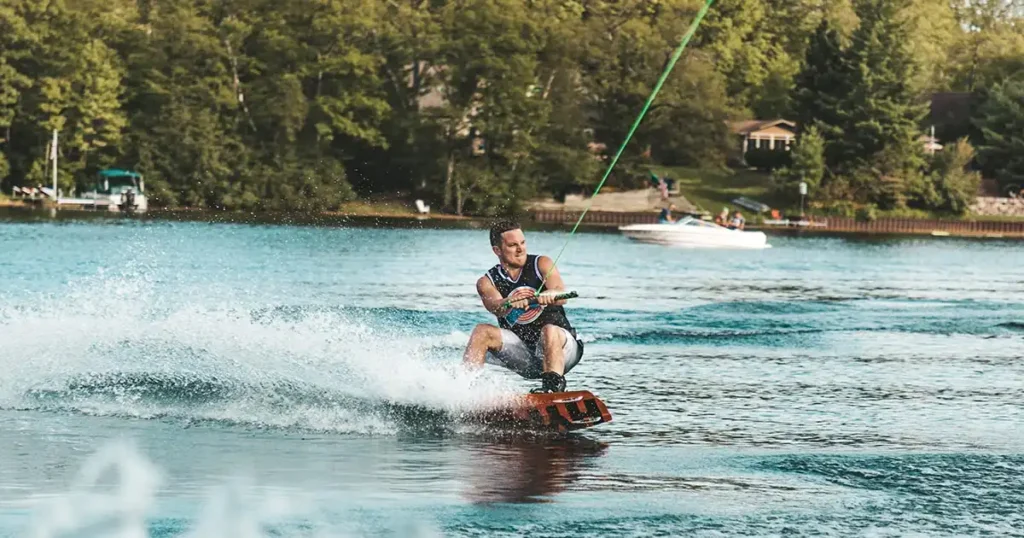
New Zealand is indeed a fantastic destination for water sports enthusiasts. With its stunning coastline, pristine lakes, and vibrant marine life, the country offers a wide range of opportunities for surfing, sailing, scuba diving, and other water activities. Here are some reasons why New Zealand is a paradise for watersports:
Surfing
New Zealand has world-class surf breaks along both the North Island and South Island coasts. Raglan, Piha, and Gisborne are just a few popular spots for surfing, with consistent swells and beautiful beaches attracting surfers from around the world.
Sailing
With its extensive coastline and numerous lakes, New Zealand provides excellent conditions for sailing. The Hauraki Gulf, Bay of Islands, and Marlborough Sounds are renowned sailing destinations, offering stunning scenery and opportunities for both recreational sailing and yacht racing.
Scuba Diving and Snorkeling
New Zealand’s underwater world is teeming with diverse marine life, unique rock formations, and clear waters. The Poor Knights Islands, the Bay of Islands, and the Fiordland National Park are popular spots for scuba diving and snorkeling, offering the chance to explore colorful reefs, caves, and encounter marine species like dolphins, seals, and even the elusive kiwi fish.
Kayaking and Paddleboarding
New Zealand’s rivers, lakes, and coastal areas provide ideal settings for kayaking and paddleboarding. From tranquil paddles on scenic lakes like Lake Wanaka or Lake Taupo to adventurous trips down white-water rivers like the Shotover or the Rangitata, there are options for all skill levels.
Jet Boating and Whitewater Rafting
For adrenaline seekers, New Zealand offers thrilling jet boating experiences in iconic locations such as Queenstown’s Shotover River or the Huka Falls in Taupo. Whitewater rafting is another exhilarating water activity, with rivers like the Buller, Rangitata, and Kaituna offering exciting rapids and breathtaking scenery.
Whether you are a beginner or an experienced water sports enthusiast, New Zealand provides a wide range of opportunities to enjoy surfing, sailing, scuba diving, and various other watersports. The country’s stunning landscapes and pristine waters make it a paradise for outdoor enthusiasts and adventure seekers.
18. City of Sails
Auckland is often referred to as the “City of Sails” due to its strong association with sailing and its vibrant boating culture. The nickname highlights Auckland’s connection to the sea and its reputation as a city that embraces and celebrates maritime activities.
Auckland’s unique geographical features, such as its location on a narrow isthmus with two large harbors, the Waitematā Harbour and the Manukau Harbour, make it an ideal location for sailing and boating. The city’s waterfront areas, marinas, and yacht clubs attract sailing enthusiasts from around the world.
The nickname “City of Sails” not only reflects the high number of boats and yachts in Auckland but also represents the city’s love for the sea and its strong maritime heritage. The city’s sailing culture is further reinforced by hosting prestigious sailing events like the America’s Cup, which has brought international attention and recognition to Auckland as a prominent sailing destination.
Overall, the nickname “City of Sails” is a fitting representation of Auckland’s strong boating and sailing culture, and it showcases the city’s deep connection to the water and its recreational pursuits.
19. Clearest Water in the World
Blue Lake, in Nelson Lakes National Park of New Zealand, has the most transparent water in the world.
Blue Lake, also known as Rotomairewhenua, located in Nelson Lakes National Park on the South Island of New Zealand, is indeed considered to have some of the clearest and most transparent water in the world. In fact, according to a scientific study conducted in 2011, Blue Lake was found to have the highest measured clarity among 42 lakes around the world.
The study measured visibility by using a Secchi disk, which is a tool that measures water transparency. Blue Lake’s water clarity was measured at an astonishing average visibility of 76 meters (249 feet). This exceptional clarity is due to the lake’s unique geological and environmental conditions.
Blue Lake is a glacial lake fed by snowmelt and rainfall. The surrounding area has little vegetation or sediment runoff, which helps maintain the lake’s pristine water quality. The absence of suspended particles and the purity of the water contribute to its remarkable transparency, creating a stunning visual experience for visitors.
20. No Land Snakes
New Zealand is known for its absence of native land snakes. The country does not have any naturally occurring snake species, whether they are indigenous or introduced. This is primarily due to the country’s geographical isolation and unique evolutionary history.
The absence of land snakes in New Zealand is notable compared to many other regions around the world that do have native snake populations. The lack of snakes in New Zealand’s ecosystems has contributed to the development of unique ecological dynamics and the evolution of species without the presence of snake predators.
New Zealand does, however, have several species of native sea snakes that inhabit the coastal waters. These sea snakes are relatively rare and found in specific marine habitats.
The absence of land snakes in New Zealand is often regarded as a distinctive feature of its wildlife and adds to the country’s reputation for having unique and diverse flora and fauna.
You may also like:
Conclusion
In conclusion, New Zealand offers a captivating tapestry of interesting facts that make it a truly unique destination. From its stunning landscapes and diverse wildlife to its rich cultural heritage and pioneering achievements, there is no shortage of intriguing aspects to discover.
Whether it’s the world’s first commercial bungee jump, being the first country to grant women the right to vote, or the presence of the iconic kiwi bird, New Zealand consistently surprises and delights. With its “coolest little capital” of Wellington and the transparent waters of Blue Lake, this land of adventure and natural beauty continues to captivate the imagination.
Truly, New Zealand is a treasure trove of interesting facts waiting to be explored. We hope you would have enjoyed reading these 20 interesting facts about New Zealand.



